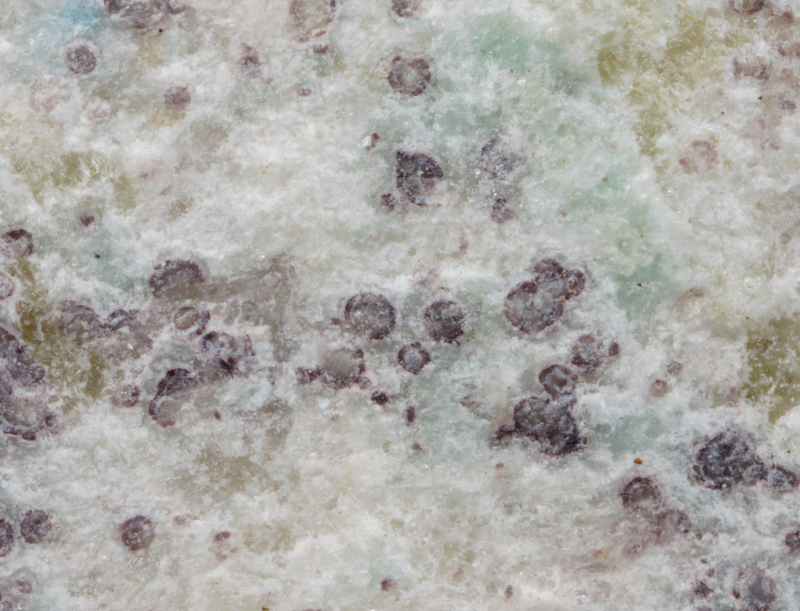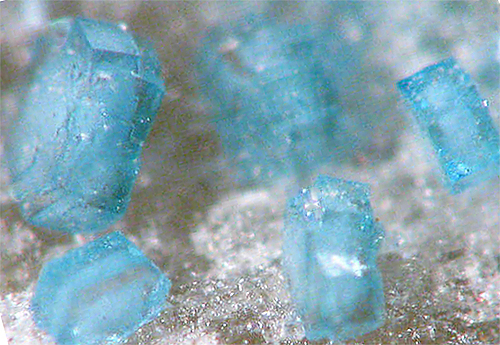Wayneburnhamite
A valid IMA mineral species
This page is currently not sponsored. Click here to sponsor this page.
About Wayneburnhamite
Formula:
Pb9Ca6(Si2O7)3(SiO4)3
previously written as Pb9Ca6(Si2O7)4(SiO4)O
Colour:
sky-blue
Lustre:
Vitreous, Resinous
Hardness:
3½
Specific Gravity:
5.271 (Calculated)
Crystal System:
Hexagonal
Name:
Named in honor of C. Wayne Burnham (1922, California, USA – 2015), geochemist and petrologist, Professor at Pennsylvania State University and at Arizona State University. He was awarded the 1998 Roebling Medal, in large part for his work on volatiles in igneous systems.
Type Locality:
Isostructural with:
The Ca (or rather Ca6-) analogue of ganomalite. Apatite polysome.
The only purely Pb-Ca hydrogen- and halogen-devoid silicate mineral. Chemically slightly similar to nasonite. Representative of a very small group of minerals with the P-6 space group. The structure of the mineral is determined. The only difference from ganomalite is that the site occupied mainly by Mn in ganomalite is occupied here by Ca.
The only purely Pb-Ca hydrogen- and halogen-devoid silicate mineral. Chemically slightly similar to nasonite. Representative of a very small group of minerals with the P-6 space group. The structure of the mineral is determined. The only difference from ganomalite is that the site occupied mainly by Mn in ganomalite is occupied here by Ca.
Unique Identifiers
Mindat ID:
47781
Long-form identifier:
mindat:1:1:47781:9
GUID
(UUID V4):
(UUID V4):
e94f547a-8b54-48bc-891f-ec3a72c3eb44
IMA Classification of Wayneburnhamite
Approved
Approval year:
2015
First published:
2016
Classification of Wayneburnhamite
9.BG.25
9 : SILICATES (Germanates)
B : Sorosilicates
G : Sorosilicates with mixed SiO4 and Si2O7 groups; cations in octahedral [6] and greater coordination
9 : SILICATES (Germanates)
B : Sorosilicates
G : Sorosilicates with mixed SiO4 and Si2O7 groups; cations in octahedral [6] and greater coordination
Mineral Symbols
As of 2021 there are now IMA–CNMNC approved mineral symbols (abbreviations) for each mineral species, useful for tables and diagrams.
| Symbol | Source | Reference |
|---|---|---|
| Wbh | IMA–CNMNC | Warr, L.N. (2021). IMA–CNMNC approved mineral symbols. Mineralogical Magazine, 85(3), 291-320. doi:10.1180/mgm.2021.43 |
Pronunciation of Wayneburnhamite
Pronunciation:
| Play | Recorded by | Country |
|---|---|---|
| Jolyon Ralph | United Kingdom |
Physical Properties of Wayneburnhamite
Vitreous, Resinous
Transparency:
Transparent
Colour:
sky-blue
Streak:
white
Hardness:
3½ on Mohs scale
Tenacity:
Brittle
Cleavage:
None Observed
Fracture:
Conchoidal
Density:
5.271 g/cm3 (Calculated)
Optical Data of Wayneburnhamite
Type:
Uniaxial (+)
RI values:
nω = 1.855(5) nε = 1.875(5)
Max Birefringence:
δ = 0.020

Image shows birefringence interference colour range (at 30µm thickness)
and does not take into account mineral colouration.
and does not take into account mineral colouration.
Surface Relief:
Very High
Pleochroism:
Weak
Comments:
sky blue (E) to lighter sky blue (O), E > O
Chemistry of Wayneburnhamite
Mindat Formula:
Pb9Ca6(Si2O7)3(SiO4)3
previously written as Pb9Ca6(Si2O7)4(SiO4)O
previously written as Pb9Ca6(Si2O7)4(SiO4)O
Elements listed:
Crystallography of Wayneburnhamite
Crystal System:
Hexagonal
Class (H-M):
6 - Trigonal Dipyramidal
Space Group:
P6
Cell Parameters:
a = 9.8953(9) Å, c = 10.2054(7) Å
Ratio:
a:c = 1 : 1.031
Unit Cell V:
865.4 ų
Z:
1
X-Ray Powder Diffraction
Powder Diffraction Data:
| d-spacing | Intensity |
|---|---|
| 4.95 Å | (52) |
| 4.45 Å | (64) |
| 3.550 Å | (77) |
| 3.232 Å | (54) |
| 3.086 Å | (100) |
| 2.847 Å | (60) |
| 2.798 Å | (48) |
| 2.734 Å | (83) |
Geological Environment
Paragenetic Mode(s):
| Paragenetic Mode | Earliest Age (Ga) |
|---|---|
| High-𝑇 alteration and/or metamorphism | |
| 32 : Ba/Mn/Pb/Zn deposits, including metamorphic deposits |
Type Occurrence of Wayneburnhamite
General Appearance of Type Material:
hexagonal tablets and prisms, up to 0.5 mm in size
Place of Conservation of Type Material:
Collections of the Mineral Sciences Department, Natural History Museum of Los Angeles County, 900 Exposition
Boulevard, Los Angeles, California 90007, USA (catalogue numbers 65639 for holotype and 65640 for cotype specimen)
Boulevard, Los Angeles, California 90007, USA (catalogue numbers 65639 for holotype and 65640 for cotype specimen)
Geological Setting of Type Material:
metasomatic mineral on fracture surfaces within vesuvianite/wollastonite rock
Associated Minerals at Type Locality:
Reference:
Kampf, A.R., Housley, R.M., Rossman, G.R. (2016): Wayneburnhamite, Pb9Ca6(Si2O7)3(SiO4)3, an apatite polysome – the Mn-free analogue of ganomalite from Crestmore, California. American Mineralogist 101, 2423-2429.
Synonyms of Wayneburnhamite
Common Associates
Associated Minerals Based on Photo Data:
| 10 photos of Wayneburnhamite associated with Vesuvianite | Ca19Fe3+Al4(Al6Mg2)(◻4)◻[Si2O7]4[(SiO4)10]O(OH)9 |
| 10 photos of Wayneburnhamite associated with Wollastonite | Ca3(Si3O9) |
| 1 photo of Wayneburnhamite associated with Calcite | CaCO3 |
Related Minerals - Strunz-mindat Grouping
| 9.BG. | Shuiskite-(Cr) | Ca2Cr3+Cr3+2[Si2O6OH][SiO4](OH)2O |
| 9.BG. | Alnaperbøeite-(Ce) | Ca(Ce2.5Na0.5)(AlAl2Al)[Si2O7][SiO4]3O(OH)2 |
| 9.BG. | Magnesiovesuvianite | Ca19MgAl4(Al6Mg2)(◻4)◻[Si2O7]4[(SiO4)10](OH)(OH)9 |
| 9.BG. | Alumovesuvianite | Ca19AlAl4(Al6Mg2)(◻4)◻[Si2O7]4[(SiO4)10]O(OH)9 |
| 9.BG. | Zoisite-(Pb) | (CaPb)(AlAlAl)O[Si2O7][SiO4](OH) |
| 9.BG. | Vielleaureite-(Ce) | (Mn2+Ce)(MgAlMn2+)F[Si2O7][SiO4](OH) |
| 9.BG. | Heflikite | (CaCa)(AlAlSc)O[Si2O7][SiO4](OH) |
| 9.BG. | Zilbermintsite-(La) | (CaLa5)(Fe3+Al3Fe2+)[Si2O7][SiO4]5O(OH)3 |
| 9.BG.05b | Allanite-(Ce) | (CaCe)(AlAlFe2+)O[Si2O7][SiO4](OH) |
| 9.BG.05b | Allanite-(La) | (CaLa)(AlAlFe2+)O[Si2O7][SiO4](OH) |
| 9.BG.05b | Allanite-(Y) | (CaY)(AlAlFe2+)O[Si2O7][SiO4](OH) |
| 9.BG.05a | Clinozoisite | (CaCa)(AlAlAl)O[Si2O7][SiO4](OH) |
| 9.BG.05b | Dissakisite-(Ce) | (CaCe)(AlAlMg)O[Si2O7][SiO4](OH) |
| 9.BG.05 | Dollaseite-(Ce) | (CaCe)(MgAlMg)F[Si2O7][SiO4](OH) |
| 9.BG.05a | Epidote | (CaCa)(AlAlFe3+)O[Si2O7][SiO4](OH) |
| 9.BG.05a | Hancockite | (CaPb)(AlAlFe3+)O[Si2O7][SiO4](OH) |
| 9.BG.05 | Khristovite-(Ce) | (CaCe)(MgAlMn2+)F[Si2O7][SiO4](OH) |
| 9.BG.05a | Mukhinite | (CaCa)(AlAlV3+)O[Si2O7][SiO4](OH) |
| 9.BG.05a | Piemontite | (CaCa)(AlAlMn3+)O[Si2O7][SiO4](OH) |
| 9.BG.05 | Piemontite-(Sr) | (CaSr)(AlAlMn3+)O[Si2O7][SiO4](OH) |
| 9.BG.05b | Manganiandrosite-(La) | (Mn2+La)(Mn3+AlMn2+)O[Si2O7][SiO4](OH) |
| 9.BG.05 | Tweddillite | (CaSr)(Mn3+AlMn3+)O[Si2O7][SiO4](OH) |
| 9.BG.05b | Ferriallanite-(Ce) | (CaCe)(Fe3+AlFe2+)O[Si2O7][SiO4](OH) |
| 9.BG.05 | Niigataite | (CaSr)(AlAlAl)O[Si2O7][SiO4](OH) |
| 9.BG.05 | Manganiandrosite-(Ce) | (Mn2+Ce)(Mn3+AlMn2+)O[Si2O7][SiO4](OH) |
| 9.BG.05 | Dissakisite-(La) | (CaLa)(AlAlMg)O[Si2O7][SiO4](OH) |
| 9.BG.05 | Vanadoandrosite-(Ce) | (Mn2+Ce)(V3+AlMn2+)O[Si2O7][SiO4](OH) |
| 9.BG.05 | Uedaite-(Ce) | (Mn2+Ce)(AlAlFe2+)O[Si2O7][SiO4](OH) |
| 9.BG.05a | Epidote-(Sr) | (CaSr)(AlAlFe3+)O[Si2O7][SiO4](OH) |
| 9.BG.05b | Allanite-(Nd) | (CaNd)(AlAlFe2+)O[Si2O7][SiO4](OH) |
| 9.BG.05b | Unnamed (Mg-analogue of Ferriallanite-(Ce)) | (CaCe)(Fe3+AlMg)O[Si2O7][SiO4](OH) |
| 9.BG.05b | Unnamed (Mn3+-analogue of Ferriakasakaite-(Ce)) | (CaCe)(Mn3+AlMn2+)O[Si2O7][SiO4](OH) |
| 9.BG.05b | Ferriallanite-(La) | (CaLa)(Fe3+AlFe2+)O[Si2O7][SiO4](OH) |
| 9.BG.05b | Åskagenite-(Nd) | (Mn2+Nd)(AlAlFe3+)O[Si2O7][SiO4]O |
| 9.BG.05 | Piemontite-(Pb) | (CaPb)(AlAlMn3+)O[Si2O7][SiO4](OH) |
| 9.BG.05b | Vanadoallanite-(La) | (CaLa)(V3+AlFe2+)O[Si2O7][SiO4](OH) |
| 9.BG.05b | Ferriakasakaite-(La) | (CaLa)(Fe3+AlMn2+)O[Si2O7][SiO4](OH) |
| 9.BG.05 | Ferriandrosite-(La) | (Mn2+La)(Fe3+AlMn2+)O[Si2O7][SiO4](OH) |
| 9.BG.05 | Androsite-(Ce) | (Mn2+Ce)(AlAlMn2+)O[Si2O7][SiO4](OH) |
| 9.BG.05 | Ferriandrosite-(Ce) | (Mn2+Ce)(Fe3+AlMn2+)O[Si2O7][SiO4](OH) |
| 9.BG.05a v | Unnamed (Ga-analogue of Epidote) | (CaCa)(AlAlGa3+)O[Si2O7][SiO4](OH) |
| 9.BG.05b | UM1989-32-SiO:AlCaFeHREE | (Ca0.5◻0.5REE)(AlAlFe3+)O[Si2O7][SiO4](OH) |
| 9.BG.05b | Manganiakasakaite-(La) | (CaLa)(Mn3+AlMn2+)O[Si2O7][SiO4](OH) |
| 9.BG.05b | Ferriakasakaite-(Ce) | (CaCe)(Fe3+AlMn2+)O[Si2O7][SiO4](OH) |
| 9.BG.05b | Allanite-(Sm) | (CaSm)(AlAlFe2+)O[Si2O7][SiO4](OH) |
| 9.BG.10 | Zoisite | (CaCa)(AlAlAl)O[Si2O7][SiO4](OH) |
| 9.BG.15 | Macfallite | Ca2Mn3+3(SiO4)(Si2O7)(OH)3 |
| 9.BG.15 | Sursassite | Mn2+2Al3(SiO4)(Si2O7)(OH)3 |
| 9.BG.20 | Julgoldite-(Fe2+) | Ca2Fe2+Fe3+2[Si2O6OH][SiO4](OH)2(OH) |
| 9.BG.20 | Okhotskite | Ca2Mn2+Mn3+2[Si2O6OH][SiO4](OH)2(OH) |
| 9.BG.20 | Pumpellyite-(Fe2+) | Ca2Fe2+Al2(Si2O7)(SiO4)(OH,O)2 · H2O |
| 9.BG.20 | Pumpellyite-(Fe3+) | Ca2Fe3+Al2(Si2O7)(SiO4)(OH,O)2 · H2O |
| 9.BG.20 | Pumpellyite-(Mg) | Ca2MgAl2(Si2O7)(SiO4)(OH)2 · H2O |
| 9.BG.20 | Pumpellyite-(Mn2+) | Ca2Mn2+Al2(Si2O7)(SiO4)(OH)2 · H2O |
| 9.BG.20 | Shuiskite-(Mg) | Ca2MgCr3+2[Si2O6OH][SiO4](OH)2(OH) |
| 9.BG.20 | Julgoldite-(Fe3+) | Ca2Fe3+Fe3+2[Si2O6OH][SiO4](OH)2O |
| 9.BG.20 | Pumpellyite-(Al) | Ca2Al3(Si2O7)(SiO4)(OH,O)2 · H2O |
| 9.BG.20 | Poppiite | Ca2V3+V3+2[Si2O6OH][SiO4](OH)2O |
| 9.BG.20 | Julgoldite-(Mg) | Ca2MgFe3+2[Si2O6OH][SiO4](OH)2(OH) |
| 9.BG.25 | Ganomalite | Pb9Ca5Mn(Si2O7)4(SiO4)O |
| 9.BG.30 | Rustumite | Ca10(Si2O7)2(SiO4)(OH)2Cl2 |
| 9.BG.35 | Vesuvianite | Ca19Fe3+Al4(Al6Mg2)(◻4)◻[Si2O7]4[(SiO4)10]O(OH)9 |
| 9.BG.35 | Wiluite | Ca19MgAl4(Al,Mg)8(B,◻)4◻[Si2O7]4[(SiO4)10]O(O,OH)9 |
| 9.BG.35 | Manganvesuvianite | Ca19Mn3+Al4(Al6Mg2)(◻4)◻[Si2O7]4[(SiO4)10]O(OH)9 |
| 9.BG.35 | Fluorvesuvianite | Ca19Fe3+Al4(Al6Mg2)(◻4)◻[Si2O7]4[(SiO4)10]O(F,OH)9 |
| 9.BG.35 | Cyprine | Ca19Cu2+Al4(Al6Mg2)(◻4)◻[Si2O7]4[(SiO4)10](OH)(OH)9 |
| 9.BG.35 | Hongheite | Ca19Fe2+Al4(Fe3+,Mg)8(◻4)B[Si2O7]4[(SiO4)10]O(OH,O)9 |
| 9.BG.35 | Milanriederite | (Ca18[REE])Fe3+Al4(Mg4Al4)(◻4)◻[Si2O7]4[(SiO4)10](OH)(OH)9 |
| 9.BG.35 | Manaevite-(Ce) | (Ca13Ce4[H2O]2)Mg(Al3Mg)(Mg3Ti3Fe3+2)(◻4)◻[Si2O7]4[(SiO4)8(H4O4)2]O(OH)9 |
| 9.BG.40 | Vyuntspakhkite-(Y) | (Y,Yb)4Al2.5-1.5(Si,Al)1.5-2.5(SiO4)4O(OH)7 |
| 9.BG.45 | Dellaite | Ca6Si3O11(OH)2 |
| 9.BG.50 | Gatelite-(Ce) | CaCe3(AlAl2Mg)[Si2O7][SiO4]3O(OH)2 |
| 9.BG.50 | Perbøeite-(Ce) | CaCe3(AlAl2Fe2+)[Si2O7][SiO4]3O(OH)2 |
| 9.BG.50 | Ferriperbøeite-(Ce) | CaCe3(Fe3+Al2Fe2+)[Si2O7][SiO4]3O(OH)2 |
| 9.BG.50 | Ferriperbøeite-(La) | CaLa3(Fe3+Al2Fe2+)[Si2O7][SiO4]3O(OH)2 |
| 9.BG.50 | Perbøeite-(La) | CaLa3(AlAl2Fe2+)[Si2O7][SiO4]3O(OH)2 |
| 9.BG.55 | Västmanlandite-(Ce) | CaCe3(MgAl2Mg)[Si2O7][SiO4]3F(OH)2 |
| 9.BG.60 | Radekškodaite-(La) | (CaLa5)(Al4Fe2+)[Si2O7][SiO4]5O(OH)3 |
| 9.BG.60 | Radekškodaite-(Ce) | (CaCe5)(Al4Fe2+)[Si2O7][SiO4]5O(OH)3 |
| 9.BG.60 | Radekškodaite Group | (CaM5)([Fe3+Al3]Fe2+)[Si2O7][SiO4]5O(OH)3 |
Other Information
Health Risks:
No information on health risks for this material has been entered into the database. You should always treat mineral specimens with care.
Internet Links for Wayneburnhamite
mindat.org URL:
https://www.mindat.org/min-47781.html
Please feel free to link to this page.
Please feel free to link to this page.
Search Engines:
External Links:
Mineral Dealers:
References for Wayneburnhamite
Reference List:
Hålenius, U., Hatert, F., Pasero, M., Mills, S. J. (2016) New minerals and nomenclature modifications approved in 2016, CNMNC Newsletter no 31. Mineralogical Magazine, 80 (4) 691-697 doi:10.1180/minmag.2016.080.083
Localities for Wayneburnhamite
Locality List
 - This locality has map coordinates listed.
- This locality has map coordinates listed.
 - This locality has estimated coordinates.
ⓘ - Click for references and further information on this occurrence.
? - Indicates mineral may be doubtful at this locality.
- This locality has estimated coordinates.
ⓘ - Click for references and further information on this occurrence.
? - Indicates mineral may be doubtful at this locality.
 - Good crystals or important locality for species.
- Good crystals or important locality for species.
 - World class for species or very significant.
(TL) - Type Locality for a valid mineral species.
(FRL) - First Recorded Locality for everything else (eg varieties).
- World class for species or very significant.
(TL) - Type Locality for a valid mineral species.
(FRL) - First Recorded Locality for everything else (eg varieties).
All localities listed without proper references should be considered as questionable.
Sweden | |
| Holtstam et al. (2021) |
USA (TL) | |
| Kampf et al. (2016) |
Quick NavTopAbout WayneburnhamiteUnique IdentifiersIMA Classification Classification Mineral SymbolsPronunciation Physical Properties Optical Data Chemistry Crystallography X-Ray Powder DiffractionGeological EnvironmentType Occurrence SynonymsCommon AssociatesStrunz-MindatOther InformationInternet Links References Localities Locality List








 symbol to view information about a locality.
The
symbol to view information about a locality.
The 



Commercial Quarry, Sky Blue Hill, Crestmore quarries, Crestmore, Jurupa Valley, Riverside County, California, USA